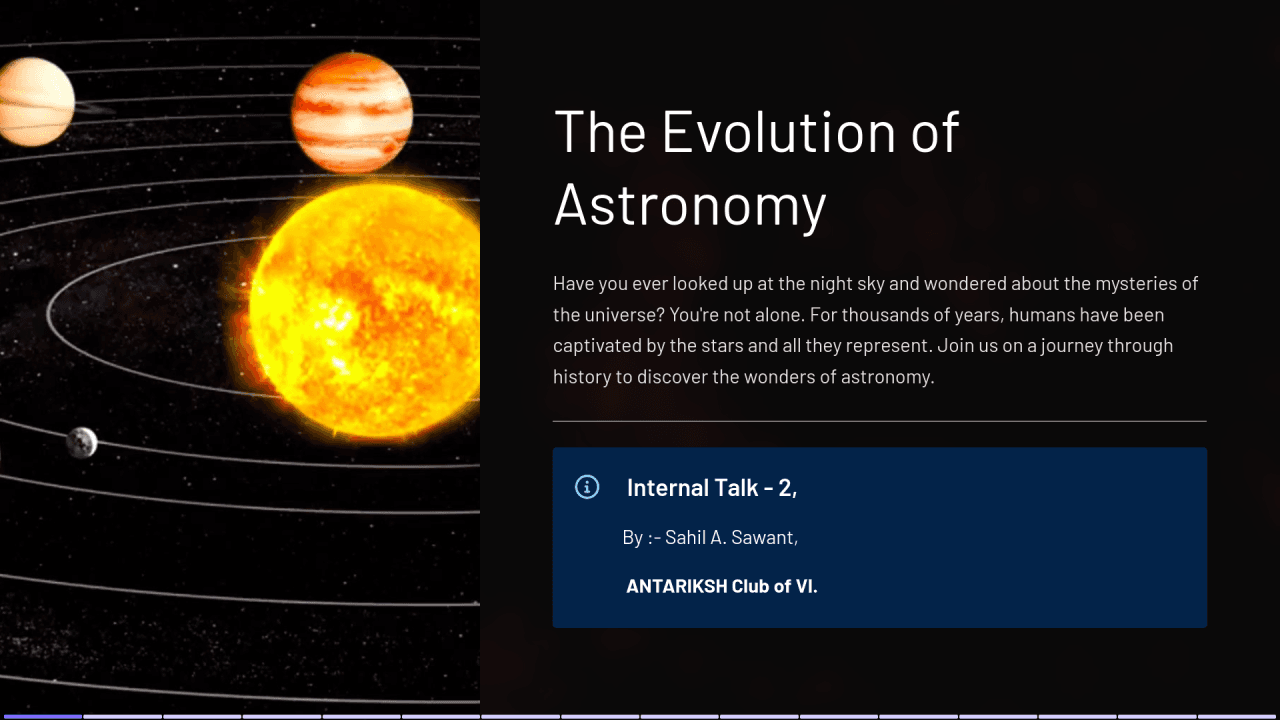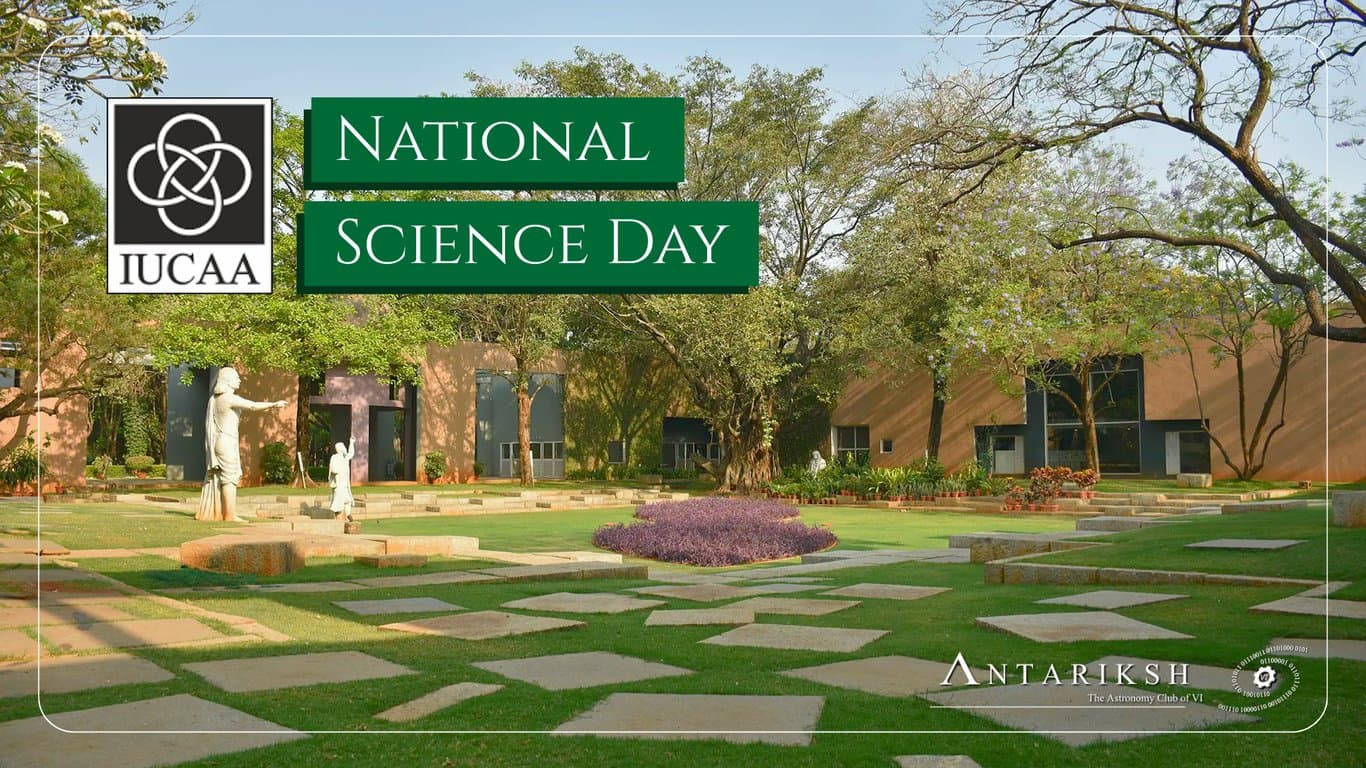On the 14th of September 2023, the Seminar Hall at Vishwakarma Institute of Information Technology (VIIT), Pune, was abuzz with excitement and curiosity as Jameer Manur Sir, the illustrious founder of Antariksh Club and a Senior Research Staff member at IUCAA (Inter University Centre for Astronomy and Astrophysics), took the stage to deliver an engaging and insightful talk on "Observational Astronomy - yesterday, today, and tomorrow."

The clock struck 4 PM, marking the commencement of an intellectual journey into the cosmos that would captivate the minds of 17 Antariksh Club members and an eager audience of 120 enthusiasts.
Introduction
The event commenced with a heartfelt felicitation by Prof. Dr. Shraddha Habbu, the Head of the Electronics and Telecommunication Engineering Department, VIIT. As Jameer Manur Sir is an alumnus of VIIT, his visit was not only a momentous occasion but also a nostalgic trip down memory lane for him.
The Invited Guest Talk wasn't just a window into the world of astronomy; it was an opportunity to showcase the Antariksh Club and its remarkable contributions to the field. This informative session was expertly hosted by two dynamic members of the club, Gyanesh Choudhary and Rajan Sudan. They provided valuable insights into the club's mission, activities, and vision.
Antariksh Club, true to its name, serves as a bridge between the cosmos and aspiring astronomers. It conducts various engaging events, such as Star Parties, Guest Lectures, Industrial Visits, and Workshops, which are designed to nurture a passion for astronomy and space sciences among its members.
Moreover, Gyanesh Choudhary and Rajan Sudan, in their introduction to Antariksh Club, highlighted the success stories of former members who have pursued careers in astronomy. These individuals once sat in the same halls, sharing their fascination for the stars and the universe, and are now contributing significantly to the world of observational astronomy.
JAMEER SIR’S TALKS
Jameer Manur Sir's Invited Guest Talk at VIIT was a captivating journey through the annals of astronomy, spanning from the past to the present, and even glimpsing into the future of this fascinating field. Here are some of the key points he eloquently shared with the audience:
1. Today's Observational and Theoretical Astronomy: Jameer Manur Sir commenced his talk by emphasizing the pivotal role of both observational and theoretical astronomy in our understanding of the universe. These two branches work in tandem, with observations grounding the theories and theories guiding the observations.
2. Celestial Bodies: The talk then delved into specific celestial bodies, including the Moon, Jupiter, and Venus. These luminous objects have been constant sources of fascination and study for astronomers, providing valuable insights into our solar system.
3. Milky Way and Emu in Australia: The Milky Way, our home galaxy, and the Emu in the night sky, as observed in indigenous Australian astronomy, were discussed. These cosmic wonders have inspired countless stargazers and astronomers throughout history.
4. The Birth of Astronomy in 1609: Jameer Manur Sir highlighted the year 1609 as a significant milestone in the history of astronomy. This was the year when the foundations of modern observational astronomy were laid, marking a crucial turning point in our quest to understand the cosmos.
5. The Eye as the Best Telescope: Acknowledging the importance of technology in modern astronomy, Jameer Manur Sir reminded us that our eyes, as the original telescopes, played a fundamental role in sparking humanity's interest in the night sky, moreover explaining how and why Human Eyes have qualities far better than the Telescope ever created.
6. Galileo's Groundbreaking Work: The talk delved into the groundbreaking contributions of Galileo Galilei, who used telescopes to observe sunspots, craters on the Moon, the moons of Jupiter, and the phases of Venus. These observations revolutionized our understanding of the solar system and challenged established dogmas.
7. Newton, Herschel, and Hubble: The discussion then moved on to luminaries such as Isaac Newton, who invented the reflecting telescope, and astronomers William Herschel and Edwin Hubble, known for their pioneering work in exploring the universe beyond our solar system.
8. Astronomy Detectors: Jameer Manur Sir touched upon the evolution of astronomy detectors, from photographic plates to modern photodetectors and charge-coupled devices (CCDs), as well as the crucial role of spectroscopy in dissecting the light from distant celestial objects.
9. Optical Astronomy Techniques: The audience was treated to insights into various optical astronomy techniques, including imaging, photometry, and spectroscopy, which continue to unveil the secrets of the universe.
10. Devasthal Observatory and TMT: The talk concluded with a glimpse into some of the world's leading observatories, with a special mention of the Devasthal Observatory, the largest of its kind globally. The future of astronomy was also discussed, particularly the Thirty Meter Telescope (TMT), a colossal instrument that promises to revolutionize our understanding of the cosmos.
In a span of just over an hour, Jameer Manur Sir managed to take the audience on an exhilarating journey through the history of astronomy, showcasing the remarkable progress made by humanity in unlocking the mysteries of the universe. His talk left the attendees not only with a deeper appreciation for the cosmos but also with a sense of wonder and curiosity that will undoubtedly inspire the next generation of astronomers.
Questions Proposed (Questionnaire)
The questions posed during Jameer Manur Sir's Invited Guest Talk added depth and insight to an already enriching discussion on astronomy. Here are the questions and brief summaries of the responses provided:
1. Why Telescopes in Space?
Answer: Telescopes in space are used to reduce the detrimental effects of Earth's atmosphere on astronomical observations. This is essential for achieving clear and sharp images of celestial objects and for conducting direct imaging without the distortions caused by atmospheric turbulence.
2. Explain Gravitational Lensing.
Answer: Gravitational lensing is a phenomenon where the gravitational field of massive objects, such as galaxies or black holes, bends the path of light from more distant objects behind them. This effect allows astronomers to see and study objects that would otherwise be obscured. It was famously predicted by Albert Einstein's theory of general relativity, and its first experimental confirmation came during a solar eclipse when Sir Arthur Eddington observed the deflection of starlight by the Sun's gravity.
3. Career Path to IUCAA.
Answer: Jameer Manur Sir shared his personal career journey, which included completing his engineering studies (B.E.), pursuing a Bachelor's in Science (B.Sc.), securing a project opportunity at IUCAA, and subsequently pursuing a Master's degree (M.Sc.). He highlighted the significance of his major project, which focused on Polarization Modulation Techniques.
4. Careers After B.Tech (Since Attendees are Pursuing B.Tech).
Answer: While specific career paths can vary, attendees were likely encouraged to explore postgraduate opportunities in related fields, such as astronomy, astrophysics, or space science, if they are passionate about pursuing a career in these areas. B.Tech graduates can also consider research positions, sciences, communication, and data analysis roles in space-related industries.
5. Astrophotography and Techniques.
Answer: Astrophotography combines artistic and scientific skills to capture the beauty of the night sky, using long-exposure photography and specialized equipment.
6. Parameters to Choose a Telescope.
Answer: Choosing the right telescope involves considering factors such as aperture size, focal length, type (refractor, reflector, or compound), mount type (equatorial or alt-azimuth), and intended use (e.g., visual observation, astrophotography, or specific celestial targets). Jameer Manur Sir likely provided guidance on how to select a telescope that suits individual needs and goals… (also, money matters)
7. Future Opportunities to Study in India.
Answer: Attendees may have inquired about educational and research opportunities in the field of astronomy and astrophysics in India. The response could include information about universities, research institutes, and programs offering degrees and research positions in these domains.
8. References to Learn: IUCAA, RPIT, IIRL, TIFR, etc.
Answer: Jameer Manur Sir may have provided recommendations for valuable resources and institutions for aspiring astronomers and astrophysicists. Institutions like IUCAA Pune, India (Inter University Centre for Astronomy and Astrophysics), (RRI) Raman Research Institute , Indian Institute of Astrophysics ( IIA) , and Tata Institute of Fundamental Research (TIFR) are renowned in the field and offer educational and research opportunities.
These questions and responses added depth and practical insight to the talk, making it a well-rounded exploration of both the theoretical and practical aspects of astronomy and the opportunities available for those interested in pursuing careers in this exciting field. 🌠🔭📚
Conclusion
As the clock struck 5:30 PM, the talk concluded, but the conversations and aspirations it ignited are sure to continue long into the starry nights ahead. Jameer Manur Sir's visit to VIIT, along with the Antariksh Club's commitment to nurturing young astronomers, serves as a shining example of how education and passion can come together to explore the mysteries of the cosmos. Thank you, Jameer Manur Sir, Antariksh - Astronomy Club , and Vishwakarma Institute of Information Technology , for this remarkable opportunity to delve into the world of observational astronomy.




The stars have never shone brighter in our hearts and minds. 🌌🔭✨



